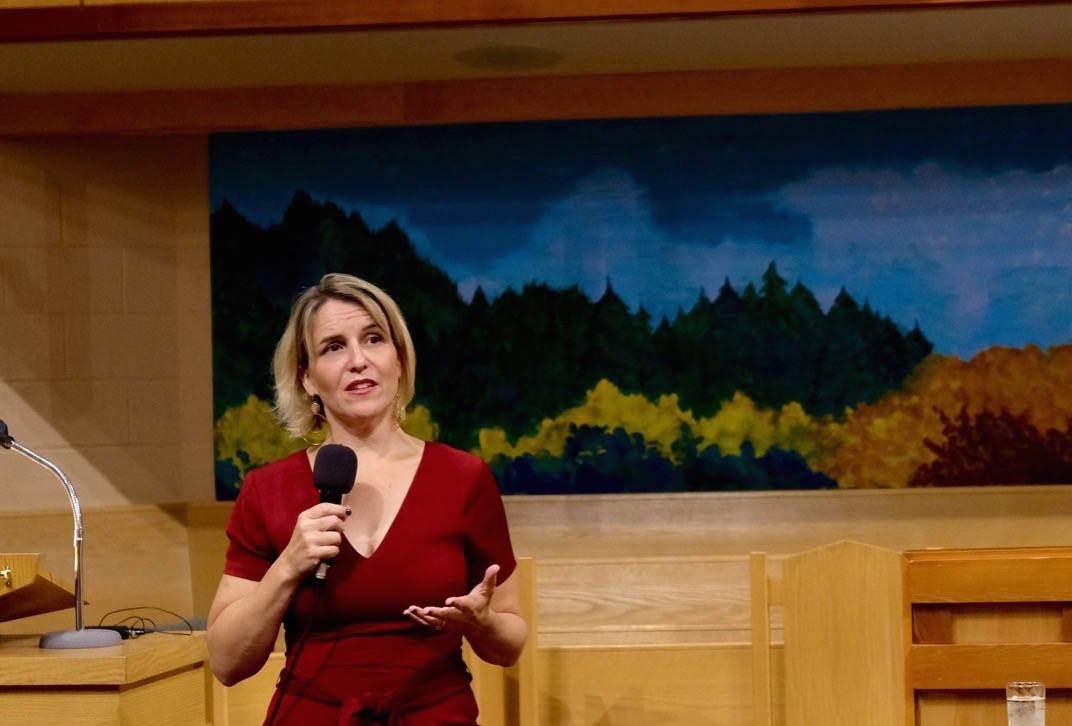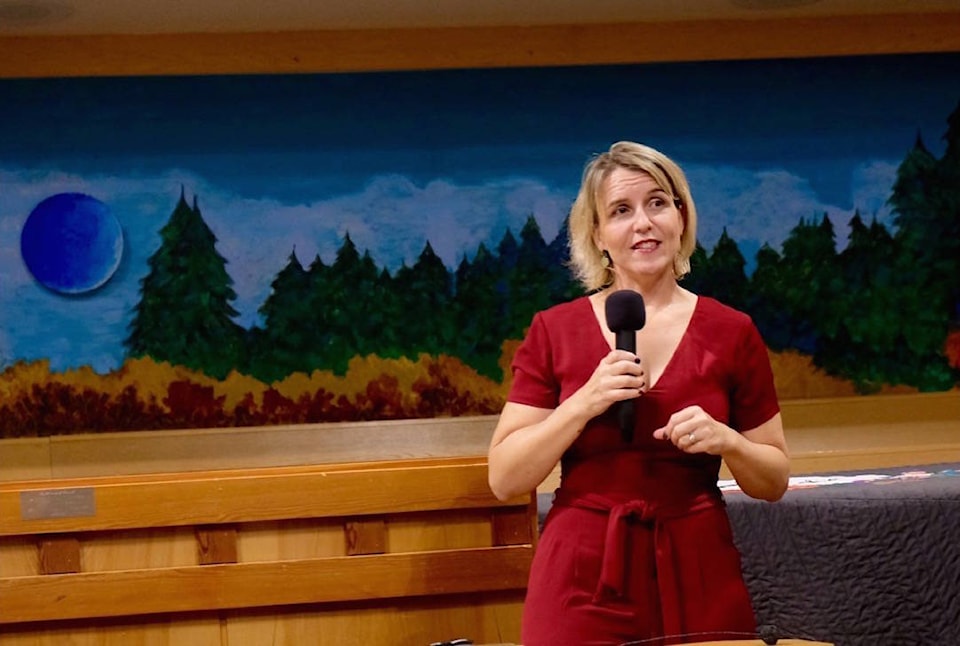As soon as they met, Shannon Moroney and Jason were intensely attracted to each other.
He said, “There’s something you need to know right away before we get to know each other.”
He told her he had been in prison for 10 years and was currently on parole with a life sentence.
“When somebody has a life sentence there is only one thing they could have done,” Moroney told a Nelson audience last week. “I was shocked, because there was nothing about him that would make me think such a thing could be possible. He did not look like what I thought a murderer looks like.”
Moroney was in her late 20s, single, working as a teacher with children who had been involved with the justice system.
Jason had committed the murder when he was 18, in a fit of anger.
In prison for ten years, and then in his life on parole, she said, Jason was a well-loved and respected person, supported by the community. He was working as a chef in a soup kitchen.
“I loved spending time with him. He was a true kindred spirit. I could absolutely be myself with him. We had so many things in common. I decided he was the person for me.”
But she had misgivings, too.
“I didn’t want his past, it was so heavy. Parole is life, you are always a ward of the system. There were lots of things to think about.”
She took him home to meet her parents without telling them about his past. They loved him. Then she told them.
“Their reaction was the same as mine: shock, disbelief, sadness. They had a lot of questions. Then they welcomed him into our life. He had the best second chance anyone could have. You couldn’t not love him.”
‘Your husband was arrested last night’
They bought a house in Peterborough, Ont., and got married. Moroney was 30 years old. She got a job as a guidance counsellor working with homeless youth. Jason went to art school and got a job in a health food store.
In Toronto at an educators’ conference in 2005, Moroney answered her hotel door to a policeman.
“Your husband was arrested last night. He’s charged with 17 offences, including sexual assault, aggravated sexual assault, and kidnapping.”
The officer said Jason had turned himself in to the police.
Moroney travelled back to Peterborough to discover that Jason was charged with sexually assaulting a customer at knifepoint at the health food store, locking her in the basement. He then immediately assaulted a second customer, locking her in the basement also. He choked one of them to unconsciousness.
Then he took the two women to his and Moroney’s house and held them there before eventually calling the police and turning himself in.
In the midst of Moroney’s terror and panic, she thought of the victims: Who are they? Are they all right?
Her mother said, “Didn’t he realize how much we loved him? How could someone who was so loved do this?”
‘What happened in that prison room was a restorative dialogue’
Moroney went to visit Jason in prison.
“Here was this man in an orange jumpsuit. Was this my husband? He looked up, our eyes met, and we both began crying uncontrollably.
“Our palms were pressed together against the glass, unable to touch, but it was troubling because his hand, this hand, hurt those women. I had a million questions. I asked my mom’s question. He shook his head and said, ‘I’m so sorry I didn’t really know.’”
Jason wanted to plead guilty right from the start, but it took two years for the justice system to get him in front of a judge.
In the meantime, Moroney discovered she had no status in the process because she was neither a victim nor an offender. She visited Jason many times, trying to understand.
“It would be many visits, many conversations, many letters, before Jason would share with me what had happened to him as a child. That would never be an excuse for what he did, but it would provide understanding.
“What happened in that prison room was a restorative dialogue — unfacilitated, raw, but characterized by the most important things about restorative justice which are remorse, accountability, a willingness to try in some way somehow to make amends and take full responsibility, and on the victim’s side the opportunity to ask questions and to say how they were hurt.”
As an example of the lack of reconciliation opportunities available in the criminal justice system, Moroney was not allowed to talk to Jason’s two victims. She longed to meet them and talk with them. But the police and the Crown prosecutors would not tell her their names. Since then she has reconciled with one of them.
Moroney explained to the Nelson audience that the traditional justice system asks three questions: What law was broken? Who did it? What punishment is deserved?
Restorative justice asks: Who has been harmed? What do they need? Whose obligation is it to fulfill those needs?
‘Where is your anger?’
Restorative justice is a process that focuses on the rehabilitation of offenders through reconciliation with victims and the community at large. One of its principles is that justice should include repairing the harm. Restorative justice takes a variety of forms and is present in some communities, including Nelson, as an adjunct to the dominant justice system.
The Nelson restorative justice program was one of the sponsors of Moroney’s talk in Nelson. The program is located at the Nelson police station, staffed by volunteers, and headed by Anita Werner.
“Shannon Moroney pointed to a number of problems with the criminal justice system that alienate victims from the process,” Werner said. “She highlighted how restorative justice can bring healing.”
In the meantime Moroney went through depression, PTSD, public rejection and stigma, alienation from many friends and family, biased and insulting media coverage, and loss of her job and income.
She said that through all her visits to Jason she felt every emotion but anger, and her lack of anger disappointed some of her friends. “Where is your anger?” they would ask. “I will be here for you when you get angry.”
She came to the conclusion that in the current system of courts and the support systems related to it, you can’t care about both the victim and the offender. So she started studying trauma and restorative justice and she took up painting as both art and therapy.
At the sentencing hearing, Jason read a statement that he and Moroney had written together. After the sentencing, “everyone went home, but there was no peace to be found in that experience. I felt worse than ever.”
Then one day anger arrived.
‘Offenders are not monsters’
“It was huge and scary because I now know I have that in me, am I capable of violence, not the kind Jason committed but I could drive my car angrily and cause an accident, I could treat people badly, I could be bitter, I could be resentful, and seeing that and looking at it, thought I am not going to go that way. I love life. I am a middle class, educated white woman with a loving family and English is my first language. That is luck and that is privilege, and I need to do something with this.”
Since then she’s become a prominent speaker and writer on the subject of restorative justice, victim’s rights, and forgiveness.
“We are opening ourselves up to understand the ripple effects of crime, the effects on victims plus their family, friends, people close to them, the community. Offenders are not monsters — they also have someone in their lives who will be affected by this and let’s not forget that 70 per cent of people incarcerated in Canada are parents.”
In 2011 Moroney published a memoir, Through the Glass, and in 2015 produced a radio documentary for CBC about the families of offenders. She has remarried and is the mother of twins.
The other sponsor of Moroney’s Nelson talk was the Mir Centre for Peace at Selkirk College. Jennie Barron is the centre’s chair and she teaches Peace and Justice Studies at Selkirk.
“It is a troubling story but there is beauty in a sense that is shows that justice does not have to be a zero-sum game,” Barron said. “We can denounce the crime, we can honour the courage of the survivors of violence, and still recognize the human frailties of those who have caused the harm. We can empathize with both — it does not have to be one at the expense of the other.”

